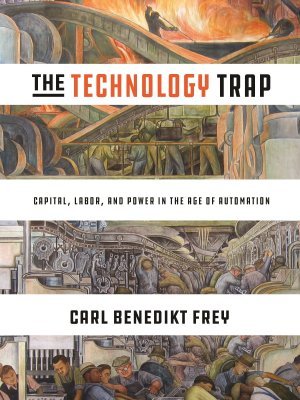Automation is here. More and more jobs are being carried out by robots and computers and, for millions, the future of work looks bleak. In fact, none of this is new. Machines have threatened humans intermittently for hundreds of years. “We have been here before” is the central message of a new book from Swedish-German economist and economic historian, Carl Benedikt Frey.
Frey is Oxford Martin Citi Fellow at Oxford University where he directs the programme on Technology and Employment at the Oxford Martin School. He first made international headlines with a 2013 paper, co-written with Michael Osborne, in which they argued that 47% of all jobs in the United States were susceptible to automation. Frey’s new book, The Technology Trap – Capital, Labor, and Power in the Age of Automation, examines the impact of the great waves of technology which have swept across history, how humans have responded, what the future might hold, and how to mitigate against any accompanying social turmoil. Frey spoke from Oxford to Acumen editor Chris Gibbons. The conversation began with the first Industrial Revolution, when the Luddites and many others really did smash the machines.
The electoral districts that were most exposed to automation...were much more likely to opt for Donald Trump
One of the key arguments of the book is that many of the changes we are seeing today – the hollowing out of middle-income jobs, wages falling behind output growth, economic polarisation translating into political polarisation – also happened during the days of the Industrial Revolution. Of course, people are not smashing machines today, and the big difference is that in the industrial West, people have the right to vote. They can make their voices heard by other means than with sticks and stones, such as showing up at election day. The Luddites rioted against the mechanised factories and went out and smashed machinery, but they didn’t change much of the course of history, because they were essentially politically disenfranchised. They petitioned parliament to block the introduction of machinery, and they rioted against the factories, but the British government essentially forced mechanisation onto the population. Property ownership remained a requirement for voting even with the Reform Act of 1867. It’s important to remember that many of the revolutionary technologies of the Industrial Revolution also created political revolutions along the way.
How did the British government deal with that threat? It is an important question because it gave Britain an absolute industrial head-start over its European neighbours.
Various petitions to parliament were ignored, although there were many debates on the subject. Essentially, the opponents of machinery achieved nothing. In terms of the Luddite riots, the British government responded by sending out troops against the rioters. The army that was sent out against the Luddites was, in fact, larger than the army that Wellington took against Napoleon in the Peninsular War of 1808.
The Luddites had a point: machines did replace humans, causing untold human misery in the factories - William Blake’s “dark, satanic mills” - which emerged as the Industrial Revolution unfolded. How long did that suffering last?
What economists regard as the ‘short-run’ during the Industrial Revolution was seven decades – or roughly three generations. From the Luddite’s point of view, smashing machines was the rational response because they were not the ones who stood to benefit from mechanisation. Later generations certainly did, but at the time the Luddites had no way of knowing this.
The key takeaway here is that if a machine augments my job, I’ll welcome it, but if it replaces me, then I will probably try and smash it – literally, or through devices like regulation?
Take an innovation like the telescope. It didn’t replace any people; it allowed us to see new and inconceivable things. That is very different from, let’s say, the power loom which replaced people doing handloom weaving. That’s why weavers rioted against mechanisation. I think the distinction between replacement and augmentation is useful to describe the likelihood of unrest.
The Second Industrial Revolution was all about electricity and the internal combustion engine. It was driven not in Britain, but in the USA. Why were machines not smashed then?
For a variety of reasons. One is certainly that many of the technological innovations of the late 19th and early 20th centuries were enabling in character. They created many new jobs in vast, new industrial undertakings related to automobiles, telephones, electric machinery, and so on. Many people in the countryside left for better-paying jobs in factories and, consequently, the mechanisation of agriculture only followed cheap labour drying up in the countryside. Another part of the reason probably has to do with the fact that governments diffused the losses incurred upon people suffering from mechanisation. The rise of the welfare state, following the Great Depression made losing one’s jobless harsh. Labour unions also became increasingly influential and played a role in managing the transition of workers between various functions within companies, often together with management. Lastly, and perhaps more importantly, many farmers realised that for their children to prosper in the Second Industrial Revolution, they would need an education, and the high school movement equipped people with skills that allowed them to take on new and higher-paying jobs.
the distinction between replacement and augmentation is useful to describe the likelihood of unrest.
Fast forward to today. We’re in the throes of the Fourth Industrial Revolution – computers, technology and Artificial Intelligence (AI). Many, many jobs have already been lost. You spoke about the hollowing out of the American middle class. What do you mean by that?
What we’ve seen since the early 1980s is that jobs that are routine or repetitive, that can easily be specified in computer codes by programmers, have gradually disappeared as computer technologies have become more pervasive and cheaper. In particular, middle-income jobs in manufacturing, which allowed many men and their families to attain a middle-class lifestyle without going to college, are those that have vanished as a consequence. On average, people with college degrees have continued to do well, taking on jobs in tech industries and professional services. Those without a college degree, on the other hand, have not adjusted well. Many have dropped into low-skill, low-income jobs that have been left largely unaffected by automation (at least so far), like receptionists, waiters, cashiers and so on.
This, of course, has consequences, including identity politics and the rise of Donald Trump. One remarkable statistic you’ve produced: looking at the states of Michigan, Pennsylvania and Wisconsin, which Trump swept in 2016, you say that those states would have gone to Hilary Clinton “had the number of robots in America’s factories not increased since the 2012 election”. Is a vote for Trump the modern, democratic equivalent in the US of smashing your machine?
Anything counterfactual needs to be taken with a pinch of salt, but if you want to understand why three key swing states like Michigan, Wisconsin and Pennsylvania, which had been in safely Democratic hands every presidential election since 1992, suddenly ended up being won by the Republican candidate – Donald Trump – automation is unquestionably one of the key reasons. The electoral districts that were most exposed to automation were, our analysis shows, much more likely to opt for Donald Trump relative to Mitt Romney in the 2012 election. These were the places where the Republican Party made the largest gains in voting share.
It is important to remember that technology shocks rarely occur evenly and across space. There are more robots in Michigan alone than in the entire American West. Where there are robots is also where many of America’s problems are. Rising unemployment in the Rust Belt, due to automation and globalisation, has also caused the opioid crisis and has led to an increase in suicide and crime, faltering marriage rates, and a range of social problems as communities have been left in ruins. So, it’s hardly surprising that these are the places that are opting for radical political change.
Where do we stand now? Trying to predict the future is, of course, futile, but we can see at least big trends – AI is one that you’ve focused on.
What we find is that despite the anecdotes about computers and artificial intelligence taking over the jobs of the relatively skilled, like doctors and lawyers, it’s the lower-income jobs that are most exposed to automation. In the United States, for example, there are 3.5 million cashiers today, but if you go through an Amazon Go store you won’t see a single one. There are currently only 13 Go stores in America, but as the technology improves, this number will inevitably rise over the next decade. Another 3.5 million truck, taxi and bus drivers are exposed to the rise of autonomous vehicles. It is true that self-driving cars and trucks are not sufficiently adequate yet, but every revolution in technology has started with imperfect technology. The early steam engines were merely used to drain coal mines and even that they did not do particularly well.
Overall, roughly 47% of jobs are at high risk of automation, according to our estimates. When Michael Osborne and I published this study a couple of years ago now, we also published a detailed list of over 700 occupations with their relative exposure to automation. Some colleagues teased us because we found that fashion models were highly exposed to automation. Today, generative adversarial networks (GANs) exist and essentially create models from thousands of pre-existing images, which are already being used by Dior and other companies. The bottom line is that the potential scope of automation is significant, and I do not think we overestimated it.
Importantly, while people are becoming more exposed to automation, they are becoming less exposed to globalisation, because most people already work in non-traded sectors of the economy. The rise of China has already happened, and hiking tariffs are not going to bring jobs back. Even in China, many blue-collar jobs are already being automated away. So, like we have already seen a backlash against globalization, we may see a backlash against automation. Indeed, a 2017 Pew research survey shows that 85% of Americans favour policies to restrict automation beyond hazardous jobs.
If we acknowledge that jobs are being lost, what avenues are open to governments to soften the impact?
There is often a sense that if we have a big challenge, we require one big policy idea to face up to it. One point I try to make in the book is that there is no such single policy. Instead, there are several things that individually may seem minor but collectively can make a very big difference.
...it’s the lower income jobs that are most exposed to automation.
For example, close to where I grew up in southern Sweden, the city of Malmö specialised in building ships. When its shipyards closed in the early 1990s, many people suffered because that industry supported the city, if not directly, then indirectly. The city did poorly until the time of the construction of the bridge to Copenhagen. This meant that people could stay put in Malmö, where housing was cheap, and commute to Copenhagen, where there were well-paying jobs. Because people spent most of their money locally and in the community in which they lived, this gave a boost to the local service economy and created a virtuous cycle. Today, the region is one of the most dynamic labour markets in Europe.
Looking forward, there is the possibility of connecting places that are much further apart. If you think about a commute today, for work, between Cleveland and Chicago – a six-hour drive - it would be entirely unfeasible. But a feasibility study is being done into connecting the two by Hyperloop. That would turn a six-hour drive into 28 minutes, which is a feasible commute to work. Essentially, two labour markets could become one.
Connecting places will be critical, because if you look at the economic and political polarisation of recent decades, much relates to the geography of new jobs, which have mainly emerged in places with skilled populations like in the Bay Area, London, Stockholm, Munich, Milan, and so on. What happens then is that when you create new tech jobs in a city, those people tend to demand lots of local, in-person services. As they go to the hairdresser, do grocery shopping, take a taxi and so on, they create new jobs in the local service economy. At the same time, in manufacturing cities, where jobs have disappeared, the local service economy has taken a hit. We solve many of our problems by connecting places that are in decline with cities that are booming.
Another area where more needs to be done is in skills and training. While we need to be very humble about our ability to predict the skills of the future, we do know that early deficits in maths and reading prohibit learning later in life. People who have such deficits early on are also much less likely to go to college. To bridge such deficits, investments in early childhood education is essential, as the Nobel Laureate James Heckman has shown.
Lastly, we can compensate the losers to automation. Tax credits for the bottom end of income distribution, for example, can make low-paid work pay better. Also, if somebody switches out of a middle-income job to a low-income job, because of automation or import competition, the government could insure against that and top up part of their income. That would make it more desirable to take on a job even if it pays less, rather than switching out completely into unemployment. Wage insurance already exists in the United States, for example, but regrettably only applies to those losing their jobs to Chinese imports.
Your book deals first with Britain and Europe and then, mostly, America. But if the people who are going to be left behind by automation are the badly educated, where might that leave Africa – including South Africa - with tens of millions of young people who are hopelessly badly educated?
When I worry about this, I worry more about the developing world than the developed world. Because every country we know of which has grown rich over the past 50 years, has done so by shifting low-skilled labour from agriculture to manufacturing. This is getting harder as factories are becoming more automated. In countries like Britain, Germany and the United States, manufacturing employment peaked around about 30%. More recently, it’s already peaking in countries like China, India and Brazil below 20%.
Historically, there used to be a very close connection between industrialisation and urbanisation. That link has broken down because of the rise of megacities in Africa, which have been built on the extraction of natural resources. Huge service economies have been created around that. At some point, however, those resources are going to run out, and unless you have something that can replace those industries, those cities are likely to become places with a lot of problems. Natural resource extraction is not a sustainable development model.
The automation of manufacturing, however, does not mean the end of development. Countries may not be able to industrialise the same way in the future, but by investing in education and moving towards more skilled, professional services and tech industries, they will also generate demand for local, in-person services which are still hard to automate. By investing in education and creating the infrastructure for technology industries to flourish, countries like South Africa can still prosper. But it may have to leapfrog industrialisation itself.
...early deficits in maths and reading prohibit learning later in life...
One common argument is that countries in the developing world if they specialise in tech industries, will be competing with tech companies in the United States, which are at the frontiers of AI. To a certain extent that is true, but many local companies have a better understanding of the local customer. For example, one reason that Baidu out-competed Google in China is that they understood that Chinese people search differently to American users.
* The Technology Trap – Capital, Labor, and Power in the Age of Automation is published by Princeton University Press and is available online at https://press.princeton.edu/titles/13489.html








